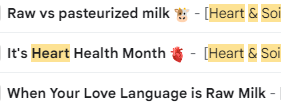Brands and copywriters obsess over subject lines and preview text. Tweak a word there, add an emoji there, A/B test every single email…
All in pursuit of squeezing an extra 2-3% open rate out of their list.
That’s a HUGE waste of time. Email’s not about “tricking” people into opening with hacks. The subject line and preview have something to do with opens, but focusing too much on them can be counterproductive.
But when you cultivate your list correctly and focus on the correct things, your subject and preview are more of an accessory.
Below, I’ll show you the real reason your best customers open and how to get there… so you don’t have to slave over your subject line and preview text so much. Plus, a few other reasons open rates can be misleading.
The Best Brands Don’t Worry About Subject Lines — Here’s Why
“Hacking” your subject line and preview, studying and implementing all sorts of stupid psychological tricks… these things are not productive.
Sometimes, they’re harmful. Customers open clickbaity subject lines, see no value in the email, and leave. They get annoyed and unsubscribe.
The REAL game is building an audience that wants to open.
“What does that even mean, Bradley?”
Customers open emails to get some sort of value from an authority they trust.
This means building a real connection with your audience. Making them look forward to your emails.
Do this over the long term, and your open rates will take care of themselves.
The example I always use is Chris Orzechowski.
I own everything he’s sold (besides his eCom-only coaching programs, of course). I have worked with his clients through his agency.
Yet I still open something like 60% of his emails regardless of subject line (and buy some of his new offers when relevant).
Why?
Because he’s hilarious. And in many cases, I learn something from him.
Granted, most of his subjects are pretty good. The dude’s an email marketer, after all.
But he one time accidentally dropped his reply-to email as his subject line and I STILL opened.
It’s not just personal brands that nail this.
Heart & Soil is a great example. I’m a long-time subscription customer, yet I still open some of this brand’s emails.
I know their copywriter, Luke Heffernan. He’s deadly (and the inspiration behind this article).
His subject lines cover topics the customer is interested in — weight loss, gut health, recipes, etc.
But not all of them are “brilliantly clever.” They get straight to the point.
A few examples:

That one in the middle isn’t even “compelling.”
However, I bet open rates were about on par (read: high) because the audience has been “trained” to expect helpful and entertaining content. In this case, something about heart health.
One other example to drive the point home (that Heart & Soil’s copywriter, Luke, came up with):
“But if Joe Rogan sent you an email, you’d open it regardless of the subject line.
Why?
Because it’s JOE ROGAN.”
(Credit to the original LinkedIn post)
How To Build an Audience That Renders Open Rates Moot
Here’s how to build an audience that opens no matter your subject line and preview text:
Mail Regularly and Consistently
You have to mail more than once a week on a regular cadence.
This keeps you at the customer’s top of mind, offers them a stream of value, and trains them to look forward to your emails at predictable times throughout the week.
For example, a client of mine has a YouTube channel and a paid membership offer. His audience was already used to his Monday YouTube uploads and their accompanying “new video email.”
Those emails consistently score high opens AND clicks regardless of our subject/preview. People know Monday is video day. They know he sends an email every Monday for it.
See? Simple.
Another example is a health/fitness client I once worked with. We mailed Monday, Tuesday, Thursday, and Friday at 7pm. Each day hit one of four big goals that resonated with our audience. Each email offered something helpful (such as problem/solution) and pitched one of our supplements.
Open rates were pretty consistent (and high) no matter my subject line. The audience had been trained over a couple of years to expect valuable emails with offers on those days at those times.
Set Expectations Early
Your “email list onboarding” should tell new subscribers exactly what to expect. Things like:
- How often you email
- What you email about
- Any other things to expect by being on the list
This’ll make sure people who get on your list don’t get overwhelmed or angry at your frequency and cadence. And, if they get angry (which rarely happens), you can point to the warning you gave them!
The squeeze page/popup (where people give you their email/SMS) should tell them this. The Welcome Sequence can get a bit deeper and explain why your emails are worth opening and reading in the long-term.
For example, my own squeeze page (where people get on my list to grab my lead magnet) tells them I’ll be mailing daily.
My welcome email reiterates this point and expands by explaining that I am trying to help them with said free advice and offers. By the time someone’s getting my emails, they’ve seen two “warnings” about my email frequency.
Make it Feel Like a “Person”
Readers’ eyes glaze over when emails sound “corporate.”
Write like a real person, albeit polished and dialed in. That means you don’t “write exactly like you talk,” but the words should flow naturally from your mind to your fingers and out onto the page.
Just read this very blog post.
See what you notice.
Line breaks. Varied sentence structure. Not entirely “formal” grammar. A bit of my voice in it.
It feels more like I am talking to you as a person, but not exactly like how I would talk IRL. It’s a polished version. I go on more tangents and say “um” when I talking IRL, but not here.
Be a Little Controversial
Drama. Controversy. Strong opinions. Taking sides.
People love this stuff. You can use this to your advantage (like I do a bit with this article).
One way to do this is to “throw stones at common enemies.” Dunk on “the other side” in a niche-relevant debate/conflict.
For example, Heart & Soil sells desiccated animal organ supplements. Their “enemy” is Big Ag, Big Pharma, seed oils, vegans, and so on.
Their “ideal” customers hold similar negative views around these entities. They’ll get a sense of catharsis reading Heart & Soil excoriate said entities. They’ll open Heart & Soil emails more often when they feel like the brand is “on their side.”
Sure, being polarizing will turn some people off. You might even get some strongly worded emails about how you’re a terrible person or they can’t support a brand that believes in XYZ.
Good for them. They don’t have to. Your other customers who write back like “YES! Finally someone says it!” will see you in a much more positive light.
Why Open Rates Are Misleading Anyway
Subject lines aren’t super important for getting good opens.
But let’s take this further. Open rates themselves don’t matter much and are often a bit misleading. Here’s why…
Apple Privacy Protection
Apple Mail’s up there with Gmail as one of the most popular providers. Unfortunately, Apple Mail might be screwing with your open rate data.
In 2021, it released Apple Mail Privacy Protection. This preloads the email content, including the tracking pixel, before the user opens the email.
Thus, it registers as an “open” even if the real human being behind the email address did NOT open it.
Plus, Apple could fetch the email more than once. So your email software might register several of these false opens.
Some softwares, like Klaviyo, let you filter out MPP opens. But that adds some work to your plate and makes tracking things a bit harder.
Bots
Email servers, security tools, and spam filters scan incoming emails for threats (like phishing and other stuff).
Like MPP, this could trigger false opens by accidentally triggering the email’s tracking pixels and causing your software to mark as “open.”
The big difference here is that with Apple Mail, you know that, well, it’s Apple users. You can segment those easily to see your non-MPP opens.
But bots and whatnot differ by email client and whatnot. So it’s tough to get a 100% accurate open rate.
It Ain’t Sales
High open rates don’t equal sales or revenue. In theory, you can master the art of clickbaity, non-spam-trigger subject lines…
Yet offer little to no value in your email. Your customers roll their eyes and close it instead of reading, clicking, and buying.
I’d take lower but consistent open rates if it means I’m making cold, hard cash with every email.
Write valuable content that positions your products as THE solution (or ways to get better, faster results). Focus on getting readers to, well, read and buy.
This trains your audience to WANT to open the email for the CONTENT and OFFERS.
Think of hitting a heavy bag. You don’t punch the bag. You punch THROUGH it.
Same thing here. You don’t go for the open. You go for the CLICKTHROUGH.
It all comes back to audience cultivation and brand “indoctrination.”
If your customers see you as an authority who puts informative, entertaining content + valuable offers that solve problems in their inbox…
They’ll open, click, and buy.
So CAN You Use Open Rates?
Yes. It’s a continuous process, rather than a discrete one.
You can track trends rather than individual open rates or your average open rate on any given day. If your open rates trended upward, that is a good sign.
Indeed, there will still be MPP and bot opens. But a trend will naturally be more accurate by showing you changes.
Stop Obsessing Over Open Rates
Subject lines play a role in opens but are NOT the be-all, end-all. They play second fiddle to your audience relationship and lose a lot of their importance once you’ve cultivated such a relationship.
Focus on list health, clicks, and revenue instead. Solid CTRs are a better indication of engagement since it tells you people are reading… and are more likely to buy… while opens can be MPP, bots, or humans who open and click away immediately.
The best brands focus on writing great emails people want to read. Emails that inform, entertain, and sell. Do that, and the rest will take care of itself.
What To Do Next
- Share this article with someone who might find it helpful (or entertaining).
- Get my free eBook, Retention Prevention Pitfalls, to learn the 5 things stopping you from turning “one-and-done” customers into repeat buyers.
- Reach out to me if you have a sizable email list and want professional help getting more out of it.
